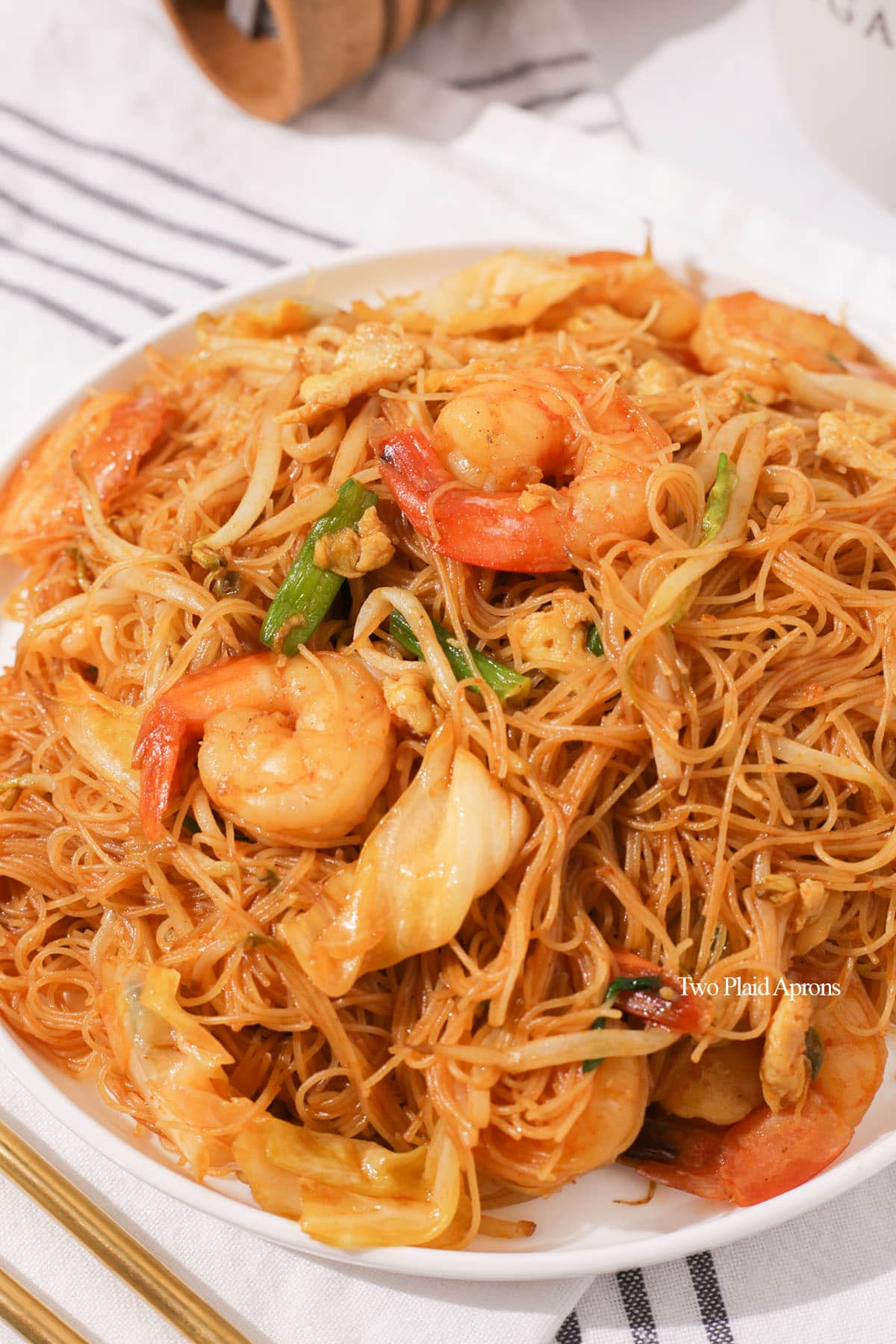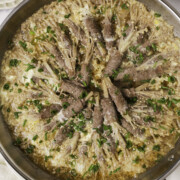Bihun goreng is an Indonesian and Malaysian stir fried rice noodle dish that's also popular in many other Southeast Asian countries. It's super easy to make, takes only 20 minutes, and is jam packed with flavors of sweet and savory heat! Although our recipe features shrimps, you can also make it with chicken instead.

If you haven't tried bihun goreng, sometimes also spelled bee hoon goreng, this may become your new favorite rice noodle recipe! It's absolutely delicious and packed with flavors from sweet to savory that also comes with just enough kick!
And if you're a noodle lover like us, also check our other quick and easy noodle recipes such as the 10 minute sesame noodles, bibim guksu, kimchi chili oil ramen, and budae jjigae. These are perfect for the weekdays! But also, if you have a little more time, we highly recommend japchae and bún thịt nướng. They're classics, but oh-so good!
Jump to:
Ingredients and substitutions
Please scroll down to the recipe card for the ingredient quantities!

For the bihun goreng:
- Thin rice noodles - Any thin rice noodles will do, but DO NOT confuse rice noodles with glass noodles!
- Shrimps - In our opinion, bihun goreng tastes the best with shrimps because the oyster sauce compliments seafood really well. However, chicken is also a popular option. So feel free to substitute.
- Mung bean sprouts - Bean sprouts are a classic in this stir fried rice noodle. It adds freshness and a nice, light crisp. Mung bean sprouts are best used within a few days of purchase, so we recommend getting them closer to when you need them. Of course, you could substitute the bean sprouts if you prefer.
- Cabbage - We prefer using cabbage, but choy sum (also known as yu choi) is often the more popular choice. Feel free to use either. If using choy sum, cut the stems thinner than the leaves and add the leaves towards the end so that it doesn't get overcooked.
- Green onion - It'll add more flavor and color to the rice noodles.
- Eggs (optional) - Although optional, we highly recommend it! Scrambled eggs always make stir fried noodle dishes more fragrant.
- Shallot and garlic - The aromatics of this rice noodle stir fry! If you don't have shallot, you could substitute with some yellow onion.
- Oil (any neutral cooking oil)

For the sauce:
- Chili sauce - We recommend finding Indonesian or Malaysian chili sauce. It is thicker, and tastes sweet and has a bit of a kick. It is not the same as sweet chili sauce. We used Dua Belibis chili sauce. You can find it at most Asian markets.
- Oyster sauce - Not only does only does oyster sauce keeps the sauce thick, it's also a little funky, which complements the shrimps really well. If you have shellfish allergy you could substitute for vegetarian oyster sauce. Depending on the brand of vegetarian oyster sauce you use, you may need to use a bit of salt or soy sauce to balance the flavor.
- Kecap manis - Also known as sweet soy sauce. It's a little bit syrupy in consistency. We've tested out both generic sweet soy sauce and Indonesian kecap manis, and the results were pretty similar. So feel free to get which ever you can find. DON'T confuse them with thick or thin soy sauce!
- Water - Just a little to thin out the sauce and help the rice noodles and vegetables cook more evenly.
- White pepper - To give a slight peppery note.
How to easily make bihun goreng
1. Soak the rice noodles: Place the rice noodles into a bowl and add enough room temperature water until the noodles are completely covered. Let the noodles soak for about 10 minutes, then drain well.


2. Prepare the sauce: Mix together the water, chili sauce, oyster sauce, kecap manis (sweet soy sauce), and white pepper. Set aside until needed.
3. Prepare the shallot and garlic: Place the roughly chopped shallot and garlic in a mortar and mash the aromatics into a paste using the pestle. This will make the vermicelli more fragrant. If you prefer or is short on time, you could also just mince by hand or blend the shallot and garlic in a food processor.


4. (Optional) Scramble the eggs: In a wok or pan heat about 1 to 2 tablespoons of oil over medium high heat. Once the oil is hot, add the beaten eggs and scramble until just cooked. Remove the eggs from the pan and set aside.

5. Stir fry the dish: In the same pan or wok over medium heat, add 2 to 3 tablespoons of oil. When the oil is hot, add the prepared shallot and garlic. Sauté briefly and add the shrimps. Sauté the shrimps with the shallot and garlic until about 70% cooked.


6. Add the prepared sauce and bring to a simmer. Add the cabbage and sauté for about 30 seconds to 1 minute. Then, add the soaked rice noodles. Stir well so the noodles are well coated.


7. Finish by adding the bean sprouts, green onions, and scrambled eggs. Stir fry and cook for another minute until the bean sprouts and green onions are no longer raw. Enjoy!

Recipe tips
- Grind the shallot and garlic with a mortar and pestle to get the most flavor out of the two aromatics. You could mince by hand or blend with a food processor but the flavor will be slightly different.
- Rinse the bean sprouts with water and drain well. This is especially important if the bean sprouts have been sitting the fridge for a couple of days.
- Use warm water to soak the rice noodles if you are short on time. Don't boil the noodles! Boiling the noodles, then stir frying can cause the noodles to break into small pieces.
- Although the eggs are optional, we highly recommend it! Stir fry noodle dishes always taste better with some scrambled egg!
- If you don't like shrimps, you can use chicken instead.
- Oyster sauce can be substituted with vegetarian oyster sauce if you have shellfish allergy. Depending on the brand of vegetarian oyster sauce you use, you may need to add a little salt or soy sauce to balance out the sweetness.

Storage and reheating
Let the leftover bihun goreng cool completely before storing in an airtight container. Keep the rice noodle stir fry in the fridge and it will be good for 3 to 4 days.
To reheat, add the leftover bihun goreng into a pan over medium heat. Add about a tablespoon of water and stir fry until everything is heated through and the noodles are soft again.

FAQ
No, rice noodles and glass noodles are different, although sometimes both are labeled as vermicelli. As the name suggests, rice noodles are made of rice. On the other hand, glass noodles are made of starch, such as mung bean starch, sweet potato starch, tapioca starch, etc.
Bihun goreng is a stir fried rice noodle dish made with thin rice noodles. You can use any brand you like, but we usually use this Wai Wai rice noodle. You can usually find these thin rice noodles at your local asian market, in the dry noodle aisle.
Yes! Absolute. Feel free to mince the shallot and garlic by hand if you are prefer or if you're short on time. You can also blend them with a food processor. We recommend mashing the aromatics into a paste because mashed paste gives the aromatic a different flavor than mincing by knife.
Nope, the eggs are option. Although, we do highly recommend. Stir fried noodle dishes always benefit from the addition of scrambled eggs. The egg soaks up all of the sauce and the eggs also makes the dish more fragrant.
If you’ve made this recipe or any recipes from our blog, please tag us on Instagram using #twoplaidaprons! You can also tag us in your Instagram stories using @two_plaid_aprons. We would love to see your creations! It absolutely makes our day! 🥰
📖 Recipe
Bihun Goreng (Stir Fried Rice Noodles)
Ingredients
For the dish:
- 3.5 ounces thin rice noodle (also known as rice vermicelli)
- 8 ounces shrimps peeled and deveined
- 8 ounces mung bean sprouts
- 3.5 ounces green cabbage cut into bite size pieces
- 1 stalk green onion cut into 1 inch pieces
- 2 large eggs beaten (optional)
- 1 medium shallot peeled and roughly chopped
- 2 cloves garlic roughly cut
- 3 tablespoons oil or as needed for cooking
For the sauce:
- 3 tablespoons water
- 3 tablespoons chili sauce
- 3 tablespoons oyster sauce
- 1½ tablespoons kecap manis sweet soy sauce
- White pepper a generous pinch or to your preference
Instructions
- Soak the rice noodles:Place the rice noodles into a bowl and add enough room temperature water until the noodles are completely covered. Let the noodles soak for about 10 minutes, then drain well.
- Prepare the sauce:Mix together the water, chili sauce, oyster sauce, kecap manis, and white pepper. Set aside until needed.
- Prepare the shallot and garlic:Place the roughly chopped shallot and garlic in a mortar and grind the aromatics into a paste using the pestle. This will make the vermicelli more fragrant. If you prefer, you could also just mince by hand or blend the shallot and garlic in a food processor.
- (Optional) Scramble the eggs:In a wok or pan heat about 1 to 2 tablespoons of oil over medium high heat. Once the oil is hot, add the beaten eggs and scramble until just cooked. Remove the eggs from the pan and set aside.
- Stir fry the dish:In the same pan or wok over medium heat, add 2 to 3 tablespoons of oil. When the oil is hot, add the prepared shallot and garlic. Sauté briefly and add the shrimps. Sauté the shrimps with the shallot and garlic until about 70% cooked.
- Add the prepared sauce and bring to a simmer. Then add the cabbage and sauté for about 30 seconds to 1 minute. Add the soaked rice noodles and stir well to coat evenly.
- Finish by adding the bean sprouts, green onions, and scrambled eggs. Stir fry and cook for another minute until the bean sprouts and green onions are no longer raw. Enjoy!
Notes
- Sauce - Stir frying the sauce helps to open up the flavors more, so don't skip it! If you like the noodles spicier, you can also add a couple tablespoons of spicy chili paste, like Sambal.
- Protein - Bihun goreng is popularly offered with either shrimps or chicken. So if you prefer chicken, cut chicken breast or thighs into strips and sauté in place of the shrimps.
- Cabbage - Normally, bihun goreng is sautéd with choy sum, also known as yu choy, but cabbage is a popular option too. You can also just substitute the cabbage for what you prefer or what you have on hand.






















Comments
No Comments